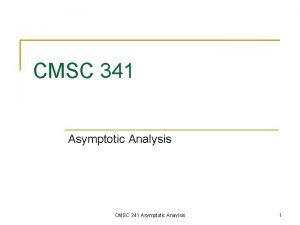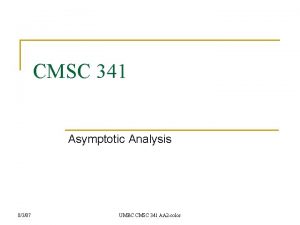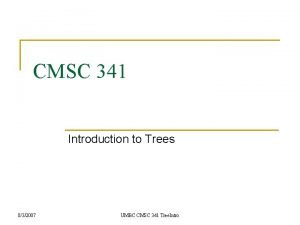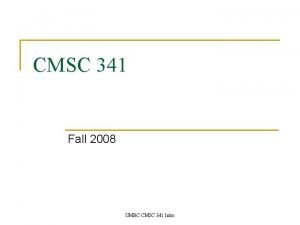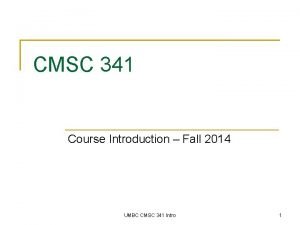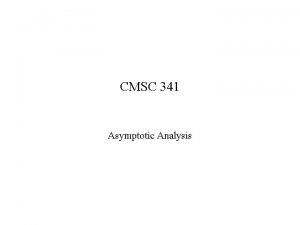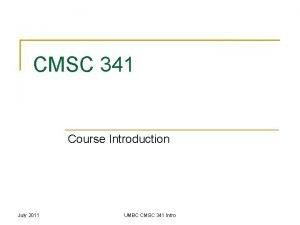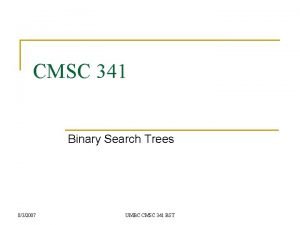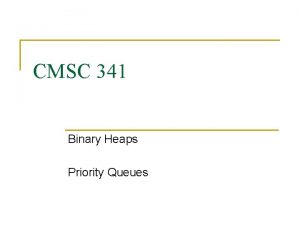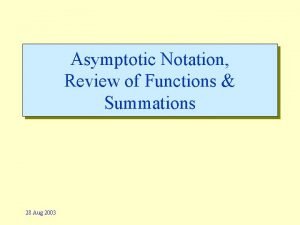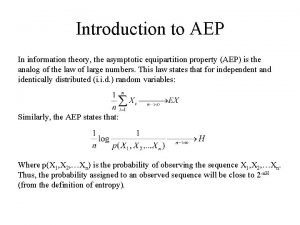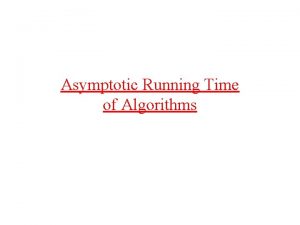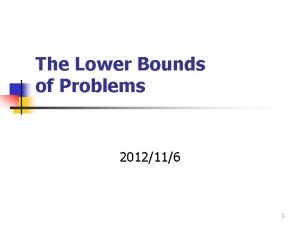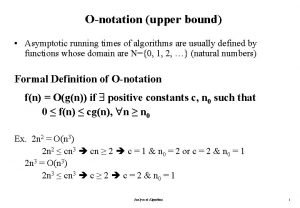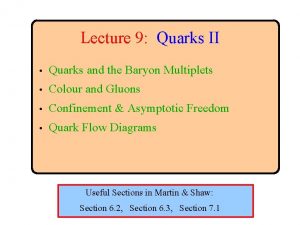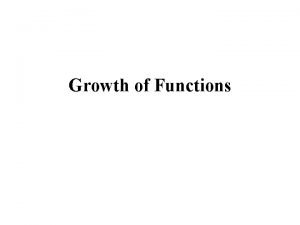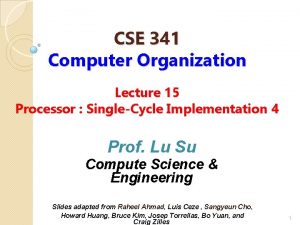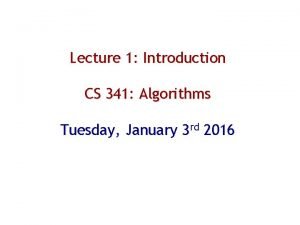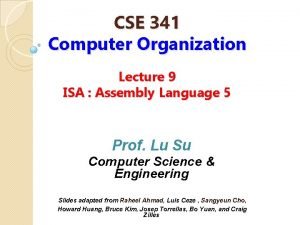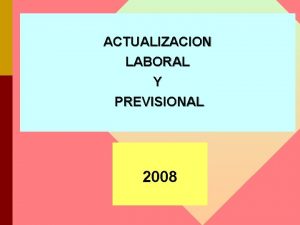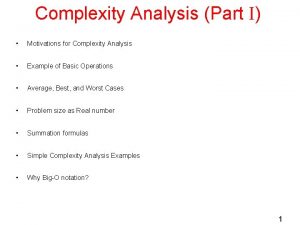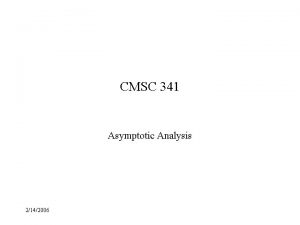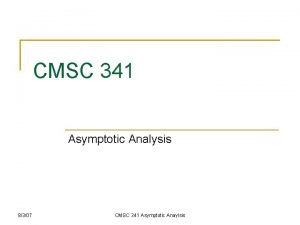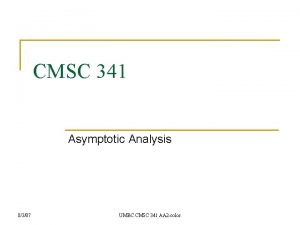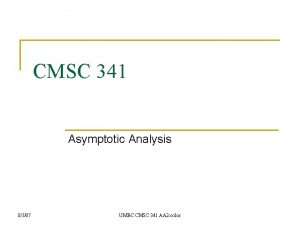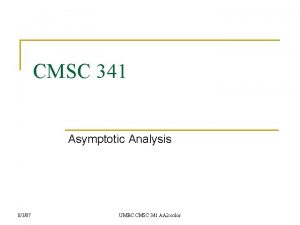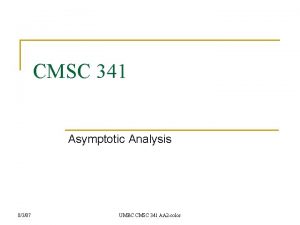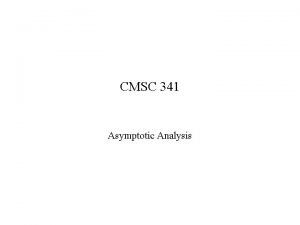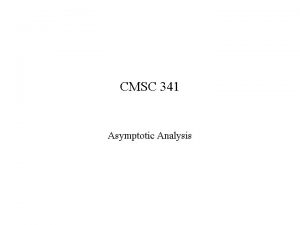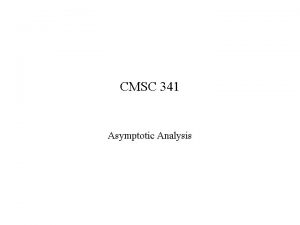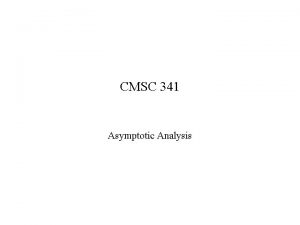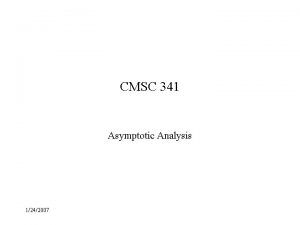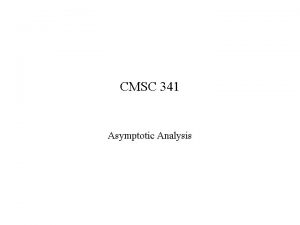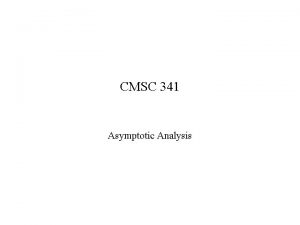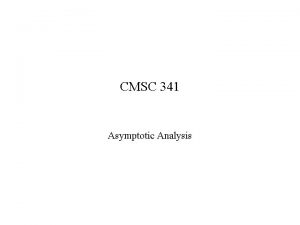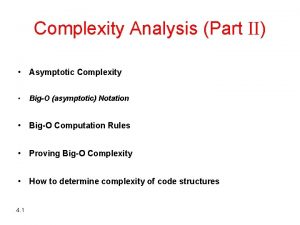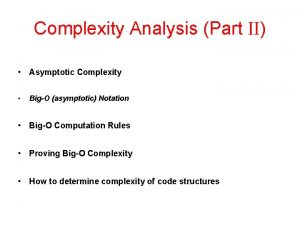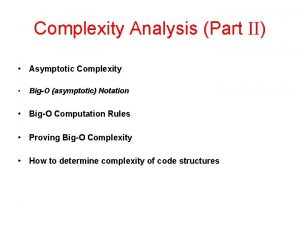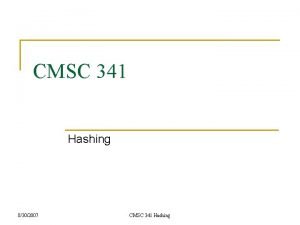CMSC 341 Asymptotic Analysis 2142006 Complexity How many





![Growth Functions (cont) Quadratic T(n) = cn 2 [ + possible lower order terms] Growth Functions (cont) Quadratic T(n) = cn 2 [ + possible lower order terms]](https://slidetodoc.com/presentation_image_h2/898b8ec90e52d7c8c3bebf7633fe533a/image-6.jpg)
![Growth Functions (cont) Exponential T(n) = cn [+ possible lower order terms] ex: constructing Growth Functions (cont) Exponential T(n) = cn [+ possible lower order terms] ex: constructing](https://slidetodoc.com/presentation_image_h2/898b8ec90e52d7c8c3bebf7633fe533a/image-7.jpg)


































- Slides: 41

CMSC 341 Asymptotic Analysis 2/14/2006

Complexity How many resources will it take to solve a problem of a given size? – time – space Expressed as a function of problem size (beyond some minimum size) – how do requirements grow as size grows? Problem size – number of elements to be handled – size of thing to be operated on 2/14/2006 2

Mileage Example Problem: John drives his car, how much gas does he use? 2/14/2006 3

The Goal of Asymptotic Analysis How to analyze the running time (aka computational complexity) of an algorithm in a theoretical model. Using a theoretical model allows us to ignore the effects of – Which computer are we using? – How good is our compiler at optimization We define the running time of an algorithm with input size n as T ( n ) and examine the rate of growth of T( n ) as n grows larger and larger. 2/14/2006 4

Growth Functions Constant T(n) = c ex: getting array element at known location trying on a shirt calling a friend for fashion advice Linear T(n) = cn [+ possible lower order terms] ex: finding particular element in array (sequential search) trying on all your shirts calling all your n friends for fashion advice 2/14/2006 5
![Growth Functions cont Quadratic Tn cn 2 possible lower order terms Growth Functions (cont) Quadratic T(n) = cn 2 [ + possible lower order terms]](https://slidetodoc.com/presentation_image_h2/898b8ec90e52d7c8c3bebf7633fe533a/image-6.jpg)
Growth Functions (cont) Quadratic T(n) = cn 2 [ + possible lower order terms] ex: sorting all the elements in an array (using bubble sort) trying all your shirts (n) with all your ties (n) having conference calls with each pair of n friends Polynomial T(n) = cnk [ + possible lower order terms] ex: looking for maximum substrings in array trying on all combinations of k separates types of apparels (n of each) having conferences calls with each k-tuple of n friends 2/14/2006 6
![Growth Functions cont Exponential Tn cn possible lower order terms ex constructing Growth Functions (cont) Exponential T(n) = cn [+ possible lower order terms] ex: constructing](https://slidetodoc.com/presentation_image_h2/898b8ec90e52d7c8c3bebf7633fe533a/image-7.jpg)
Growth Functions (cont) Exponential T(n) = cn [+ possible lower order terms] ex: constructing all possible orders of array elements Logarithmic T(n) = lg n [ + possible lower order terms] ex: finding a particular array element (binary search) trying on all Garanimal combinations getting fashion advice from n friends using phone tree 2/14/2006 7

A graph of Growth Functions 2/14/2006 8

Expanded Scale 2/14/2006 9

Asymptotic Analysis What happens as problem size grows really, really large? (in the limit) – constants don’t matter – lower order terms don’t matter 2/14/2006 10

Analysis Cases What particular input (of given size) gives worst/best/average complexity? Best Case: if there’s a permutation of input data that minimizes “run time efficiency”, then that minimum is the best case run time efficiency. Worst Case is defined by replacing “minimizes” by “maximizes”. Mileage example: how much gas does it take to go 20 miles? – Worst case: all uphill – Best case: all downhill, just coast – Average case: “average terrain” 2/14/2006 11

Cases Example Consider sequential search on an unsorted array of length n, what is time complexity? Best case: Worst case: Average case: 2/14/2006 12

Definition of Big-Oh T(n) = O(f(n)) (read “T( n ) is Big-Oh of f( n )” ) if and only if T(n) cf(n) for some constants c, n 0 and n n 0 This means that eventually (when n n 0 ), T( n ) is always less than or equal to c times f( n ). Loosely speaking, f( n ) is an “upper bound” for T ( n ) 2/14/2006 13

Big-Oh Example Suppose we have an algorithm that reads N integers from a file and does something with each integer. The algorithm takes some constant amount of time for initialization (say 500 time units) and some constant amount of time to process each data element (say 10 time units). For this algorithm, we can say T( N ) = 500 + 10 N. The following graph shows T( N ) plotted against N, the problem size and 20 N. Note that the function N will never be larger than the function T( N ), no matter how large N gets. But there are constants c 0 and n 0 such that T( N ) <= c 0 N when N >= n 0, namely c 0 = 20 and n 0 = 50. Therefore, we can say that T( N ) is in O( N ). 2/14/2006 14

T( N ) vs. N vs. 20 N 2/14/2006 15

Simplifying Rules 1. If f(n) = O(g(n)) and g(n) = O(h(n)), then f(n) = O(h(n)) 2. If f(n) = O(kg(n)) for any k > 0, then f(n) = O(g(n)) 3. If f 1(n) = O(g 1(n)) and f 2(n) = O(g 2(n)), then f 1(n) + f 2(n) = O(max (g 1(n), g 2(n))) 4. If f 1(n) = O(g 1(n)) and f 2(n) = O(g 2(n)), then f 1(n) * f 2(n) = O(g 1(n) * g 2(n)) We will prove a number of these rules by applying the definition of Big O 2/14/2006 16

Constants in Bounds Theorem: O(cf(x)) = O(f(x)) (Simplifying Rule #2) Proof: – T(x) = O(cf(x)) implies that there are constants c 0 and n 0 such that T(x) c 0(cf(x)) when x n 0 – Therefore, T(x) c 1(f(x)) when x n 0 where c 1 = c 0 c – Therefore, T(x) = O(f(x)) 2/14/2006 17

Sum in Bounds Theorem: (Simplifying Rule 3) Let T 1(n) = O(f(n)) and T 2(n) = O(g(n)). Then T 1(n) + T 2(n) = O(max (f(n), g(n))). Proof: – From the definition of O, T 1(n) c 1 f (n) for n n 1 and T 2(n) c 2 g(n) for n n 2 – Let n 0 = max(n 1, n 2). – Then, for n n 0, T 1(n) + T 2(n) c 1 f (n) + c 2 g(n) – Let c 3 = max(c 1, c 2). – Then, T 1(n) + T 2(n) c 3 f (n) + c 3 g (n) 2 c 3 max(f (n), g (n)) c max(f (n), g (n)) = O (max (f(n), g(n))) 2/14/2006 18

Products in Bounds Theorem: (Simplifying Rule 4) Let T 1(n) = O(f(n)) and T 2(n) = O(g(n)). Then T 1(n) * T 2(n) = O(f(n) * g(n)). Proof: – Since T 1(n) = O (f(n)), then T 1 (n) c 1 f(n) when n n 1 – Since T 2(n) = O (g(n)), then T 2 (n) c 2 g(n) when n n 2 – Hence T 1(n) * T 2(n) c 1 * c 2 * f(n) * g(n) when n n 0 where n 0 = max (n 1, n 2) – And T 1(n) * T 2(n) c * f (n) * g(n) when n n 0 where n 0 = max (n 1, n 2) and c = c 1*c 2 – Therefore, by definition, T 1(n)*T 2(n) = O(f(n)*g(n)). 2/14/2006 19

Polynomials in Bounds Theorem: If T (n) is a polynomial of degree x, then T(n) = O(nx). Proof: – T (n) = nx + nx-1 + … + k is a polynomial of degree x. – By the sum rule, the largest term dominates. – Therefore, T(n) = O(nx). 2/14/2006 20

Example Code: a = b; Complexity: 2/14/2006 21

Example Code: sum = 0; for (i = 1; i <= n; i++) sum += n; Complexity: 2/14/2006 22

Example Code: sum 1 = 0; for (i = 1; i <= n; i++) for (j = 1; j <= n; j++) sum 1++; Complexity: 2/14/2006 23

Example Code: sum 2 = 0; for (i = 1 ; i <= n; i++) for (j = 1; j <= i; j++) sum 2++; Complexity: 2/14/2006 24

Example Code: sum = 0; for (j = 1; j <= n; j++) for (i = 1; i <= j; i++) sum++; for (k = 0; k < n; k++) A[ k ] = k; Complexity: 2/14/2006 25

Example Code: sum 1 = 0; for (k = 1; k <= n; k *= 2) for (j = 1; j <= n; j++) sum 1++; Complexity: 2/14/2006 26

Example Code: sum 2 = 0; for (k = 1; k <= n; k *= 2) for (j = 1; j <= k; j++) sum 2++; Complexity: 2/14/2006 27

Example • Square each element of an N x N matrix • Printing the first and last row of an N x N matrix • Finding the smallest element in a sorted array of N integers • Printing all permutations of N distinct elements 2/14/2006 28

Some Questions 1. Is upper bound the same as worst case? 2. What if there are multiple parameters? Ex: Rank order of p pixels in c colors for (i = 0; i < c; i++) count[i] = 0; for (i = 0; i < p; i++) count[value(i)]++; sort(count) 2/14/2006 29

Space Complexity Does it matter? What determines space complexity? How can you reduce it? What tradeoffs are involved? 2/14/2006 30

A General Theorem Consider the limit of 2 functions, f(x) and g(x) as x grows large: l can go only to 0, ∞, or some constant. If l = 0, then f(x) is O(g(x)) If l = ∞ then g(x) is O(f(x)) l = some constant if and only if f(x)/g(x) is O(1). Example: f(x) = x 2 and g(x) = x 3 Then and x 2 is O(x 3) 2/14/2006 31

L’Hôspital’s Rule Frequently, when we try to use the general theorem, we get an indeterminate form of ∞/∞. In that case, we can use L’Hôspital’s rule, which states that We can use this rule to apply the General Theorem. The next slide is an example 2/14/2006 32

Polynomials of Logarithms in Bounds Theorem: lgxn = O(n) for any positive constant k Proof: – Note that lgk n means (lg n)k. – Need to show lgk n cn for n n 0. Equivalently, can show lg n cn 1/k – Letting a = 1/k, we will show that lg n = O(na) for any positive constant a. Use L’Hospital’s rule: Ex: lg 1000000(n) = O(n) 33

Polynomials vs Exponentials in Bounds Theorem: nk = O(an) for a > 1 Proof: – Use L’Hospital’s rule =. . . =0 Ex: n 1000000 = O(1. 00000001 n) 34

Relative Orders of Growth n (linear) logkn for 0 < k < 1 constant n 1+k for k > 0 (polynomial) 2 n (exponential) n logkn for k > 1 nk for 0 < k < 1 log n 2/14/2006 35

Big-Oh is not the whole story Suppose you have a choice of two approaches to writing a program. Both approaches have the same asymptotic performance (for example, both are O(n lg(n)). Why select one over the other, they're both the same, right? They may not be the same. There is this small matter of the constant of proportionality. Suppose algorithms A and B have the same asymptotic performance, TA(n) = TB(n) = O(g(n)). Now suppose that A does 10 operations for each data item, but algorithm B only does 3. It is reasonable to expect B to be faster than A even though both have the same asymptotic performance. The reason is that asymptotic analysis ignores constants of proportionality. The following slides show a specific example. 2/14/2006 36

Algorithm A Let's say that algorithm A is { initialization read in n elements into array A; for (i = 0; i < n; i++) { do operation 1 on A[i]; do operation 2 on A[i]; do operation 3 on A[i]; } } // takes 50 units // 3 units per element // takes 10 units // takes 5 units // takes 15 units TA(n) = 50 + 3 n + (10 + 5 + 15)n = 50 + 33 n 2/14/2006 37

Algorithm B Let's now say that algorithm B is { initialization read in n elements into array A; element for (i = 0; i < n; i++) { do operation 1 on A[i]; do operation 2 on A[i]; } } TB(n) =200 + 3 n + (10 + 5)n = 200 + 18 n 2/14/2006 // takes 200 units // 3 units per // takes 10 units /takes 5 units 38

TA( n ) vs. TB( n ) 2/14/2006 39

A concrete example The following table shows how long it would take to perform T(n) steps on a computer that does 1 billion steps/second. Note that a microsecond is a millionth of a second a millisecond is a thousandth of a second. N T(n) = nlgn T(n) = n 2 T(n) = n 3 Tn = 2 n 5 0. 005 microsec 0. 01 microsec 0. 03 microsec 0. 13 microsec 0. 03 microsec 10 0. 01 microsec 0. 03 microsec 0. 1 microsec 20 0. 02 microsec 0. 09 microsec 0. 4 microsec 8 microsec 1 millisec 50 0. 05 microsec 0. 28 microsec 2. 5 microsec 125 microsec 13 days 100 0. 1 microsec 0. 66 microsec 10 microsec 1 millisec 4 x 1013 years Notice that when n >= 50, the computation time for T(n) = 2 n has started to become too large to be practical. This is most certainly true when n >= 100. Even if we were to increase the speed of the machine a million-fold, 2 n for n = 100 would be 40, 000 40 years, a bit longer than you might want to wait for an answer.

Relative Orders of Growth constant logkn for 0 < k < 1 log n logkn for k> 1 nk for k < 1 n (linear) n log n n 1+k for k > 0 (polynomial) 2 n (exponential) 2/14/2006 41
 Asymptotic complexity analysis
Asymptotic complexity analysis Big o notation if else statement
Big o notation if else statement Cmsc 341
Cmsc 341 Umbc cmsc 341
Umbc cmsc 341 Cmsc 341
Cmsc 341 Cmsc 341 umbc
Cmsc 341 umbc Cmsc 341
Cmsc 341 Cmsc 341
Cmsc 341 Cmsc 341
Cmsc 341 Cmsc 341
Cmsc 341 Umbc cmsc 341
Umbc cmsc 341 Cmsc 341
Cmsc 341 Cmsc 341
Cmsc 341 Time space complexity
Time space complexity Asymptotic analysis
Asymptotic analysis F(n) ≥ g(n) adalah notasi jenis
F(n) ≥ g(n) adalah notasi jenis Apa itu asimtotik
Apa itu asimtotik Information theory asymptotic equipartition principle aep
Information theory asymptotic equipartition principle aep Asymptotic running time
Asymptotic running time Compare asymptotic growth rate
Compare asymptotic growth rate Asymptotic lower bound
Asymptotic lower bound Asymptotic notation exercises
Asymptotic notation exercises Asymptotically tight bound
Asymptotically tight bound Asymptotic notation graph
Asymptotic notation graph Asymptotic freedom
Asymptotic freedom Asymptotic growth rate
Asymptotic growth rate Transpose symmetry asymptotic notation
Transpose symmetry asymptotic notation Sda hymn 341
Sda hymn 341 Ecma-341
Ecma-341 Nearest hundred thousand example
Nearest hundred thousand example Gamma 333
Gamma 333 Jump instruction
Jump instruction 341 ces
341 ces Ck wraps
Ck wraps O mon sauveur a toi seul
O mon sauveur a toi seul Mgmt 341
Mgmt 341 Ncg 341
Ncg 341 Cs341 uwaterloo
Cs341 uwaterloo Cse 341
Cse 341 Actualizacion 341
Actualizacion 341 How to calculate time complexity in data structure
How to calculate time complexity in data structure Algorithm complexity analysis
Algorithm complexity analysis


